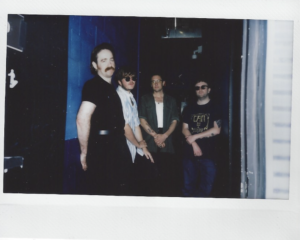“When shit hits the fan is you still a fan?” blurts Kendrick Lamar on the final track of his 2015 opus To Pimp A Butterfly. It’s a question that’s sure to split his hard-earned listenership down the middle, as the braggadocious adolescent from good kid, m.A.A.d city has transformed from a cocky backseat freestyler into a full-on rap Messiah in the short span of three years. Suffice to say, over the past year or so, shit has indeed hit the fan. The divide between urban communities and those assigned to protect said communities continues to grow, as highlighted by the recent widespread protests of the deaths of Eric Garner and Michael Brown, respectively. In terms of sheer racial tension in America, things feel pretty unstable. Thankfully, K. Dot has reemerged as a voice for the oppressed, to make some sense of it all.
Lamar’s aforementioned question to fans is telling. It seems to reveal how the rapper felt obligated to make this album, despite the downright divisive nature of its content. This isn’t “Control” Kendrick. This isn’t even “Swimming Pools” Kendrick. Here, Lamar comments on the sociopolitical climate from the inside out by taking the listener on a journey through nearly every relevant black musical movement, from jazz to p-funk to hip-hop, in just under an hour and a half. It’s an admirable feat that, surprisingly, makes for a more cohesive project than that of his major label debut — an album that’s arguably already achieved the genre’s coveted “classic” status.
The album rollout for To Pimp A Butterfly was a strange one. Last September, amidst continued unrest in Ferguson, MO, Lamar released “i,” the album’s first official single. Built primarily around an extended sample of the Isley Brothers’ 1973 hit “That Lady,” the track was fast, upbeat, and peppered with seemingly endless proclamations of self-love, resulting in a pretty polarizing first taste of the rapper’s highly anticipated new project. It was a preview of things to come, however, as the overarching message of “i,” paired with the music’s heavy soul and R&B-influence, would eventually construct one of the most important statements of our generation.
To Pimp A Butterfly is, without a doubt, Lamar’s most cohesive album to date. Musically, it’s far more consistent than good kid, m.A.A.d city, and, while the narrative might not be as linear, the thematic beats are clear. It’s an album of cautious certainty in a time of grave uncertainty — a compilation created to reassure the unassured of their worth in the shadow of the aristocracy. It’s Lamar’s crowning achievement, one that can only be understood when considered against the impossible odds of our time.
Lamar sets the stage with “Wesley’s Theory” — a deeply funky introductory track that draws its name from actor Wesley Snipes’ refusal to pay his taxes in protest of the federal government, an act that landed him in jail for tax fraud from 2010 to 2013. Produced by Flying Lotus and featuring instrumentation from Parliament Funkadelic’s George Clinton and Thundercat on bass, the song describes the exploitation of the album’s titular butterfly while satirizing a number of common hip-hop tropes in the process. It’s the perfect opening to a project that simultaneously criticizes and embraces many aspects of urban culture, segueing into the appropriately brash spoken-word interlude “For Free?”
Things really kick off when Lamar raps of a “black man taking no losses” on “King Kunta.” Named after Kunta Kinte, an 18th century West African slave whose story inspired the novel Roots and its subsequent television adaptation, “King Kunta” is a masterful exercise in shit-talking. “I can dig rapping, but a rapper with a ghost writer? What the fuck happened? / Oh no, I swore I wouldn’t tell. But most of y’all share bars like you got the bottom bunk in a two man cell,” Lamar raps. The album peaks again with “These Walls”, another Thundercat-featuring, blue-skyed funk track, with assistance from good kid, m.A.A.d city‘s Anna Wise and neo-soul singer Bilal, who each further enhance the song’s widescreen production.
The LP is tied together through pieces of a poem, written by Lamar, that show up periodically between tracks. It describes the rapper’s encounters with “Lucy,” an incarnation of the devil, who tempts him with the luxuries of fame. Lamar struggles with “survivor’s guilt” and constantly questions himself, before eventually coming to the realization that he’s fighting a “new” war based on “apartheid and discrimination.” His doubts surface on the free jazz experiment “u” (the antithesis of “i”). Here, Lamar, quite literally, hits the bottle, sobbing over the horn-based instrumental and lamenting over his growing disconnection from Compton, his home, while repeating “loving you is complicated.” The track’s abrasiveness is shocking, but many of the issues and concerns addressed on “u” are later reconciled on songs like “Alright” and “Complexion (A Zulu Love).”
“Sometimes I get off watching you die in vain,” Lamar mutters on “The Blacker The Berry,” echoing the thoughts of an unnamed third party, before declaring himself “the biggest hypocrite of 2015.” As the most straightforward boom bap track on the album, “The Blacker The Berry” takes on the challenge of confronting some glaring racial stereotypes, while, at the same time, pointing out the prevalence of black-on-black violence in urban communities — a problem that’s often even promoted in hip-hop culture. On To Pimp A Butterfly, it’s Lamar’s duty to point out these hypocrisies, even if they’re not necessarily the things his fans want to hear. Because, in 2015, shit has hit the fan, and Lamar isn’t going to let anyone get off easy.
To Pimp A Butterfly is out now via TDE/Interscope.
Shea Garner ate two Klondike bars while reviewing this, unfortunately. Follow him on Twitter @sheaDUCK.










